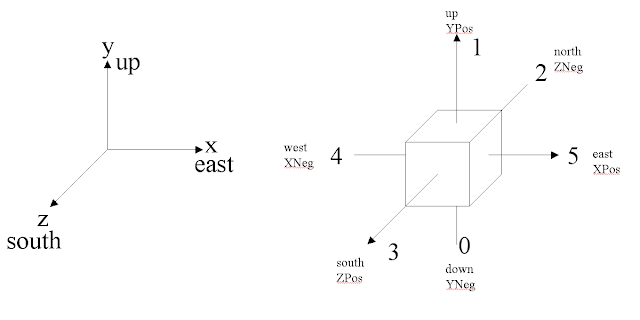Key concepts relating to blocks:
- The minecraft world is composed of a three-dimensional grid of blocks. The world grid is only 256 blocks high but extends indefinitely along the two horizontal axes.
- The blocks are grouped into 'Chunks', which comprise a cube of 16x16x16 blocks.
- Chunks are then grouped into regions; each region is comprised of 32 x 32x16 chunks. Regions are stored on disk, one per file.
- The point of all this grouping is firstly to reduce storage space (Sections which are completely empty are not saved to disk) and secondly to allow chunks to be created and loaded into memory individually as necessary, without having to store areas where the player hasn't explored.
- The coordinate system used in minecraft is shown below:
 See the EnumFacing class for a number of constants and utility functions related to the six directions (eg getOpposite(), rotateX(), getFrontOffsetX(), etc).
See the EnumFacing class for a number of constants and utility functions related to the six directions (eg getOpposite(), rotateX(), getFrontOffsetX(), etc).
At a minimum, each grid location [x,y,z] contains the following information:
- An IBlockState, which specifies the type of block at that location (eg a BlockDoor) as well as its current state (eg OPEN or CLOSED).
- An integer "SkyLight" value from 0 to 15, which specifies the amount of light this block is receiving from the sky.
- An integer "BlockLight" value from 0 to 15, which specifies the amount of light this block is receiving from nearby blocks.
IBlockState blockAtXYZ = world.getBlockState( {x,y,z});
int lightFromSky = world.getLightFor(SKY, {x,y,z});
int lightFromBlocks = world.getLightFor(BLOCK, {x,y,z});
An IBlockState is comprised of two components, the Block and its Properties (its state)
- The Block class and derived classes do not store unique information about every location in the world, they only store information related to the Block type. The Block classes hence consist mostly of methods to determine the behaviour of the block and how it is drawn on the screen. These are generally unique but not always (for example: different types of wood share the same BlockOldLog instance). The vanilla Block instances can be found in the Blocks class; for example Blocks.dirt, Blocks.sand, Blocks.water.
- Each Block may also have one or more Properties which describe the different states that the block can be in. For example- BlockLadder has a property called FACING which has four allowable values (NORTH, SOUTH, EAST, or WEST) depending on which direction it is facing. BlockOldLog has a property called VARIANT with allowable values OAK, SPRUCE, BIRCH, JUNGLE. Some Blocks have multiple properties, such as BlockBed which has
- FACING, with possible values NORTH, SOUTH, EAST, WEST;
- PART, with possible values HEAD or FOOT to define which part of the bed this is;
- OCCUPIED, possible values TRUE or FALSE;
block_bed [facing=east, part=head, occupied=false];
The state can be manipulated using
1. IBlockState.getValue(property) to get the value
of a particular property, eg
bedFacingDirection = currentBedState.getValue(FACING); to return EAST.
IBlockState newBedState = oldBedState.withProperty(FACING, NORTH);
- TileEntity, which stores custom information such as the text on signs, the list of items in a chest, etc. Most grid locations do not have a corresponding TileEntity; each chunk contains a list of TileEntities, with an entry for each TileEntity and its [x,y,z] location within the chunk. The TileEntity at a particular location is accessed using
TileEntity tileEntityAtXYZ = world.getTileEntity({x,y,z}); - Entity, used for some special "blocks" such falling blocks (sand, gravel), paintings, item frames.
Further details
The main IProperties used by vanilla are
- PropertyEnum such as VARIANT (OAK, SPRUCE, BIRCH, JUNGLE) for BlockOldLogs
- PropertyDirection such as FACING (N, S, E, W) for BlockDoor
- PropertyInteger such as AGE (0 – 7) for BlockCrops (eg wheat growth stage)
- PropertyBool – such as OCCUPIED (true/false) for BlockBed.
For each given Block, a BlockState instance is used to define the valid states that the corresponding Block can have. (The name is misleading because BlockState does not implement IBlockState!). The BlockState can be accessed using Block.getBlockState(). For example, the BlockState for BlockBed contains three properties
- FACING, with possible values NORTH, SOUTH, EAST, WEST.
- PART, with possible values HEAD or FOOT.
The BlockState for your Block is created during Block construction by
overriding Block.createBlockState().
As for versions 1.7 and earlier, minecraft only uses a total
of 16 bits for IBlockState - 12 bits for a blockID plus 4 bits for the state
information (previously called metadata)).
This means that a block must have no more than 16 unique states. Although some vanilla blocks have more than 16
combinations of properties (for example BlockDoor has 64), at most 16 of these
are actually used. In the example of
BlockBed, although there are 16 possible combinations of values, only 12 are
used– see the table below.
PART
|
HEAD
|
FOOT
|
|||
OCCUPIED
|
TRUE
|
FALSE
|
TRUE
|
FALSE
|
|
FACING
|
NORTH
|
14
|
10
|
not used
|
2
|
SOUTH
|
12
|
8
|
not used
|
0
|
|
EAST
|
15
|
11
|
not used
|
3
|
|
WEST
|
13
|
9
|
not used
|
1
|
|
Block.getMetaFromState() and Block.getStateFromMeta() are
used to interconvert between the IBlockState value and the corresponding
integer metadata value (0-15 inclusive).
When implementing Blocks with Properties, you must be careful to only
return metadata in the range 0 – 15, otherwise you will overwrite the mappings
for other blocks. Likewise, you must
make sure that your getMetaFromState() and getStateFromMeta() match each other.
During the game initialisation phases, a unique instance is
created for each block, see Block.registerBlocks(), and the Blocks class. This means that you can test for equality
using the == operator instead of having to use .equals(), for example
boolean thisBlockIsDirt = (blockAtCursor == Blocks.dirt);
Likewise, there is a unique instance for each IBlockState,
allowing for example
boolean stateHasChanged = (newIBlockState != currentIBlockState);
instead of
boolean stateHasChanged = !newIBlockState.equals(currentIBlockState);